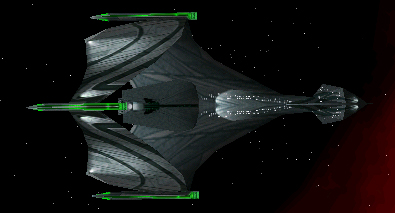Sparrowhawk class (SFC)
The Romulan Imperial High Command received a report from the Bureau of Starships for the Romulan Imperial Navy that had been three years in the making; the result of the report was to commission a class of starships that was revolutionary in its design: the Sparrowhawk class modular cruiser. The Romulan Star Empire could not afford the time or money to build a large number of specialized cruisers, so they instead built a single cruiser spaceframe to which different specialized modules could be attached. This wasn't an easy process, and required the use of a full shipyard to convert the modules, but it allowed the Romulans to build a few ships in the time available.
The Sparrowhawk-A (SPA) light cruiser was the basic and most common version of the class. It was a balanced cruiser design and arguably one of the best light cruisers in service in the known galaxy. It lacked, however, the staying power of a true heavy cruiser. The SPA, introduced in 2276, featured a crew complement of 360, a capacity of eight shuttlecraft, and was equipped with two science labs, three transporters, and two tractor beam emitters. The SPA was armed with one Type-G plasma torpedo tube, two Type-F plasma torpedo tubes, five banks of Type-1 phasers, and four banks of Type-3 phasers. It remained in service until 2301, when it was superseded by the SPA+ refit, first introduced in 2289. The SPA+ featured improved shields, and replaced the Type-G torpedoes with Type-S plasma torpedoes.
The Sparrowhawk-G (SPG) commando cruiser carried the 240 fighting men of an imperial Marine battalion and proved itself time and again as capable of fighting its way to its destination. Introduced in 2278, the SPG featured a crew complement of 440 — including the Marine battalion, which was housed in eight barracks — a capacity of twelve shuttlecraft, and was equipped with four cargo areas, two science labs, seven transporters, and two tractor beam emitters. The SPG was armed with one Type-G plasma torpedo tube, two Type-F plasma torpedo tubes, three banks of Type-1 phasers, and four banks of Type-3 phasers. It remained in service until 2290, and was superseded by the SPG+ refit, introduced in 2291. Like the SPA+, the SPG+ featured improved shielding and replaced the Type-G torpedoes with Type-S plasma torpedoes.
The Sparrowhawk-L (SPL) light command cruiser, introduced in 2282, featured modules intended to provide a command version of the Sparrowhawk class, with increased command facilities at the price of cramped crew quarters. The SPL featured a crew complement of 400, a capacity of eight shuttlecraft, and was equipped with two science labs, three transporters, and two tractor beam emitters. The SPL was armed with one Type-G plasma torpedo tube, two Type-F plasma torpedo tubes, five banks of Type-1 phasers, and six banks of Type-3 phasers. It remained in service until 2299, when it was superseded by the SPL+ refit, introduced in 2287. Like the SPA+, the SPL+ featured improved shielding and replaced the Type-G torpedoes with Type-S plasma torpedoes.
The Sparrowhawk-J (SPJ) assault cruiser was introduced in 2295, in an attempt to field ships with more plasma firepower. The SPJ modules reduced the number of phasers, but increased the number of plasma torpedo tubes. The SPJ was not considered to be well-designed, but was used to support base assaults. The SPJ was only built on refitted SPA+ hulls, and featured a crew complement of 360, a capacity of eight shuttlecraft, and was equipped with two science labs, three transporters, and two tractor beam emitters. The SPJ was armed with three Type-S plasma torpedo tubes, two Type-F plasma torpedo tubes, three banks of Type-1 phasers, and four banks of Type-3 phasers.
The Sparrowhawk-Z (SPZ) acceleration cruiser was introduced in 2309, and was outfitted with faster and more powerful engines to fulfill a reconaissance role.The SPZ featured a crew complement of 360, a capacity of eight shuttlecraft, and was equipped with two science labs, three transporters, and two tractor beam emitters. The SPJ was armed with six Type-F plasma torpedo tubes, five banks of Type-1 phasers, and four banks of Type-3 phasers.[1]
Sparrowhawk class vessels
SFC Timeline
R.I.S. Adversary • R.I.S. Auspex • R.I.S. Avenger • R.I.S. Maximus Brutus • R.I.S. Caelum • R.I.S. Defiance • R.I.S. Executioner's Song • R.I.S. Fearless • R.I.S. Fendere • R.I.S. Formidable • R.I.S. Fortiter • R.I.S. Furious • R.I.S. Harrower • R.I.S. Havoc • R.I.S. Inclutus • R.I.S. Infinity • R.I.S. Invenio • R.I.S. Licentia • R.I.S. Loyal Warrior • R.I.S. Monolithic • R.I.S. Nexum • R.I.S. Numinous • R.I.S. Nympha • R.I.S. Oris • R.I.S. Praeses • R.I.S. Pyrrhic • R.I.S. Sabbatical • R.I.S. Senatus • R.I.S. Sinvenio • R.I.S. Slanderous • R.I.S. Sovanius • R.I.S. Sparrow • R.I.S. Spartan • R.I.S. Species • R.I.S. Specificity • R.I.S. Spurious • R.I.S. Superator • R.I.S. Tranchet • R.I.S. Triumph • R.I.S. Varrix • R.I.S. Vindex • R.I.S. White Hawk
Notes and References
- ↑ Bethke, Erik (Producer). Starfleet Command. Lead Designer: Erik Bethke. Senior Designer: Chris Taylor. Mission Scripting by Lance Watanabe. Campaign Mission Design by Scott Bennie. Game Design by Marc Hertogh and Tom Hughes. SFB Consultant: Tom Hughes. Interplay Inc.. 15 September 1999.

